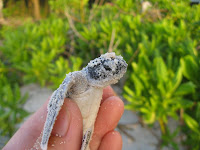We hopped on a bus to Baie Ste Anne, as the bus winds its way right through the Vallee and down to the coast at the other side. We had taken this route many times before, but never had we had the chance to get off and explore. The entrance for the Vallee De Mai is about half the distance from Grand Anse to Baie Ste Anne, and it only took 10 minutes before we got off the bus and stepped out in the scorching sun surrounded by lush green vegetation. Once the rattle of the aged bus had left we heard an unusual call neither of us were familiar with, as we looked up we saw black parrots flying over our heads. Quite large about the size of a crow, they were squawking as they flew around the tops of the trees and palms - this only increased my excitement to see this place, the lush green tropical vegetation beckoning us forward.

The Vallee de Mai is a palm forest and a remnant of when Seychelles' granitic islands were still part of Gondwanaland, the huge land mass which included what is now Africa, Madagascar and India. Millions of years of isolation enabled a unique community of plants and animals to develop and now some species can be found nowhere else. Up to the 1930s the Vallee De Mai remained as a virgin forest and was little affected by man, however a new land owner decided to beautify the valley and decided to introduce a variety of ornamental trees and fruit trees. But in 1948 the area was acquired by the Government as a major water catchment area fort the island of Praslin and rehabilitation became a priority and in 1966 it became a nature reserve. The rehabilitation involved the gradual removal of the exotic and invasive species and already today after a short time, the Vallee is starting to take on its primeval appearance once again.

The reserve is most important for its coco de mer palm surrounded by myth s and legends this palm has male and female palms, the female produces the largest seed in the world and it can weigh more than 20kg and takes between 6 and 7 years to ripen. Growing up to 30m for the male and 24 m for the female these palms are thought to be able to live for between 200 and 400 years. These coco de mer palms grow naturally on only two small islands in the whole world, here at the Vallee De Mai, Praslin and on the island of Curieuse 2 nautical miles north of Praslin.
We were in for treat, as we walked up the entrance path the tropical forest got thicker and before long we were under cover of the huge palms and lush green vegetation. The wind blew and the sound of the palms crashing together was like something we have never heard before, the coco de mer palm has no trunk, just the long leaves coming from its base and their movement in the wind rattled the leaves together. They towered above us and we were completely enclosed by them, with no sky to be seen, we could hear rain, but didn't feel a drop. The bird noise of black parrots and bulbuls completed the experience, we could've been in an extensive tropical forest miles from anywhere, rather than a remnant on Praslin, as I stood and looked I tried to imagine that this is what it would've been like, and that some of these plants would've been on Aride too.
We walked up to the view point and there we were welcomed by a bulbul, a beautiful bird, obviously he had been fed at this point before, he was curious and tried to investigate my bag.

He hoped along the bench to where we were sitting and sat and watched, bright orange beak and feet with lovely spiky black crown, and iridescent green back and wings. 
The view point gave height to look over the mass of green tropical vegetation, the sun brought out all the different shades and colours, the black parrots flew across in front of us calling and we had the place to ourselves, there was no other sound than the natural sounds, the wind blowing through the palms and the birds calling out from the shelter of the forest - a very beautiful place, like going back in time.

The view point gave height to look over the mass of green tropical vegetation, the sun brought out all the different shades and colours, the black parrots flew across in front of us calling and we had the place to ourselves, there was no other sound than the natural sounds, the wind blowing through the palms and the birds calling out from the shelter of the forest - a very beautiful place, like going back in time.



































































































